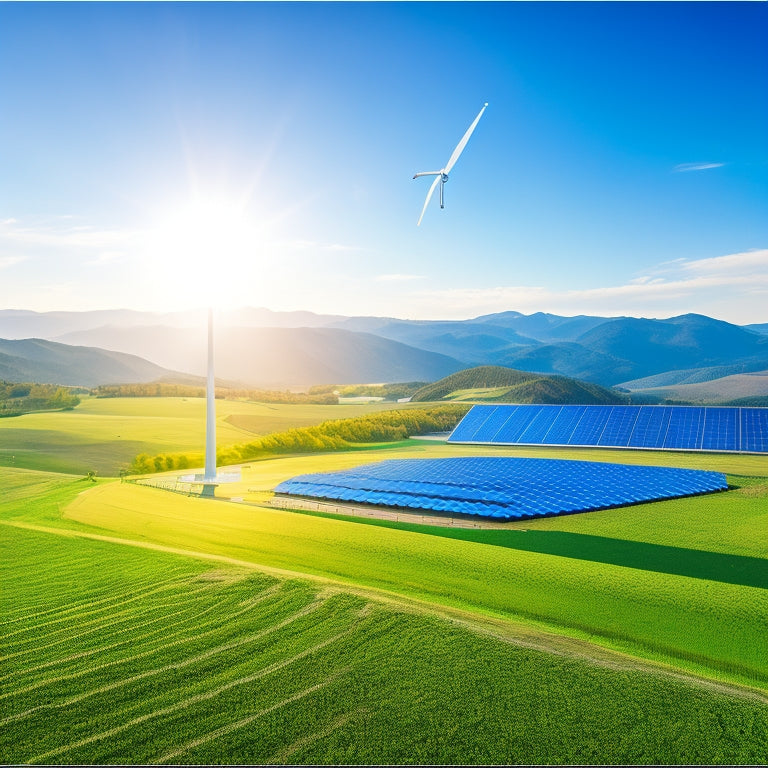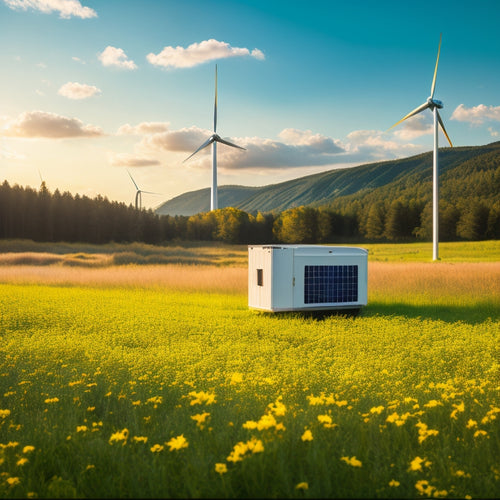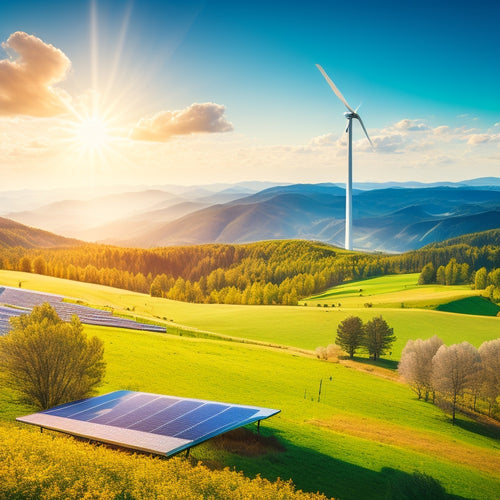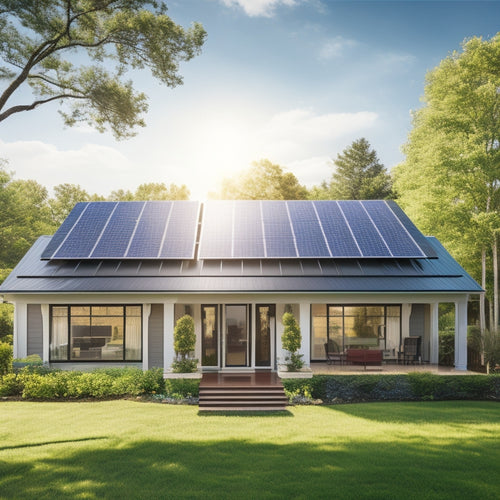
What Renewable Energy Storage Solution Is Right for Your Business
Share
Choosing the right renewable energy storage solution for your business requires evaluating cost-effectiveness, energy consumption, and reliability. Consider options like lithium-ion batteries for their high energy density and long lifespan, though they come with a higher initial cost. Assess your energy usage patterns to identify peak demand periods and guarantee your storage solution aligns with your operational needs. Efficiency is key; prioritize systems that offer better performance and lower waste. By analyzing these factors, you can make a well-informed decision customized to your needs, setting the stage for deeper understanding into optimizing your energy strategy.
At a Glance
- Assess your initial investment capacity and explore financing options like loans or power purchase agreements to manage costs effectively.
- Evaluate energy reliability needs, focusing on backup power capabilities and grid stability to ensure consistent energy supply.
- Analyze historical energy consumption patterns to identify peak demand periods and optimize storage solutions accordingly.
- Prioritize higher efficiency storage options, as they reduce waste and lower operational costs, enhancing overall performance.
- Choose the right battery technology, such as lithium-ion or flow batteries, based on your space requirements and energy density needs.
Cost-Effective Long-Term Investment
When considering renewable energy storage solutions, it's essential to evaluate your initial investment against potential long-term savings.
Battery storage enhances energy independence from the grid, promoting sustainability, and effective solutions can greatly reduce your energy costs over time.
Initial Investment Considerations
Investing in renewable energy storage solutions can greatly affect a business's financial environment, making it essential to carefully assess initial costs. When you evaluate potential systems, you should consider not only the price of the equipment but also associated installation and maintenance expenses.
These factors can vary considerably depending on the technology you choose, such as batteries or pumped hydro storage.
It's vital to investigate financing options that can help ease the burden of upfront costs. Many businesses utilize loans, leasing arrangements, or power purchase agreements to mitigate the initial investment.
Additionally, don't overlook the available tax incentives that can significantly lower your overall expenditure. Federal and state programs may offer credits or deductions that enhance the economic viability of your project.
Return on Investment
Understanding the potential return on investment (ROI) from renewable energy storage solutions can greatly influence your decision-making process. When considering these systems, it's crucial to evaluate not only the initial costs but also the long-term financial benefits.
By investing in renewable energy storage, you can access considerable savings on energy bills and reduce your reliance on grid power.
One of the most persuasive reasons to pursue this path is the availability of financial incentives and tax credits. Many governments offer programs designed to offset the upfront costs associated with renewable energy technologies.
These incentives can greatly enhance your ROI, making it a smarter financial choice for your business.
Moreover, as energy prices continue to rise, your investment in storage solutions becomes increasingly beneficial. You'll gain greater control over your energy consumption and can even sell excess energy back to the grid, creating additional revenue streams.
Enhanced Energy Reliability
When you invest in battery storage options, you greatly enhance your energy reliability.
These systems not only provide backup power during outages but also contribute to grid stability by balancing supply and demand.
By optimizing energy usage through battery systems, you can minimize dependence on the grid while also reducing utility bills.
Battery Storage Options
In the quest for enhanced energy reliability, battery storage options are emerging as an essential solution for businesses seeking to optimize their renewable energy use. By selecting the appropriate battery technology, you can guarantee a more consistent energy supply, even when renewable sources fluctuate.
Here's a quick overview of popular battery storage options:
| Battery Type | Advantages | Considerations |
|---|---|---|
| Lithium Options | High energy density, fast charging | Higher initial costs |
| Flow Batteries | Scalability, long cycle life | Larger space requirement |
| Thermal Storage | employs existing infrastructure | Efficiency may vary |
| Compressed Air | Environmentally friendly | Requires significant space |
Lithium options are often favored for their efficiency and compact size, ideal for businesses with limited space. Flow batteries excel in scalability, making them suitable for larger operations. Thermal storage can capitalize on existing systems, providing a cost-effective solution, while compressed air storage offers eco-friendly alternatives, though at the expense of space.
Grid Stability Benefits
Battery storage options not only enhance energy reliability but also play a significant role in maintaining grid stability. By integrating these systems into your business, you can help address renewable integration challenges that often arise from intermittent energy sources like solar and wind.
When the sun isn't shining or the wind isn't blowing, battery storage allows you to store excess energy generated during peak production times, ensuring that you have a dependable power supply when you need it most.
Moreover, implementing effective grid resilience strategies is vital for businesses looking to mitigate the risk of outages and fluctuations.
Battery systems can stabilize the grid by providing instantaneous backup power, balancing supply and demand, and reducing the strain on traditional energy sources. This capability not only supports your operational needs but also contributes to a more resilient energy infrastructure overall.
Key Functional Characteristics
When considering renewable energy storage solutions, you should focus on two key functional characteristics: energy density and cost-effectiveness.
Energy density impacts how much energy can be stored in a given space, influencing your storage system's efficiency and footprint. For instance, efficient battery selection is essential for optimizing the performance of your energy storage solutions.
Additionally, a thorough cost-effectiveness analysis will help you determine the long-term viability of your investment, ensuring that you maximize returns while minimizing expenses.
Energy Density Considerations
How essential is energy density in selecting renewable energy storage solutions for your business? Energy density refers to the amount of energy stored per unit volume or weight, and it plays an important role in determining which storage technologies are most suitable for your operational needs.
Different energy types, such as solar or wind, require varying storage capacities to guarantee consistent power delivery, especially during periods of low generation.
When evaluating storage solutions, consider how energy density impacts space constraints and logistical efficiency. For instance, lithium-ion batteries offer high energy density, making them ideal for businesses with limited space, while pumped hydro storage, though effective, requires significant physical infrastructure.
Choosing the right storage technology hinges on understanding not just the energy density but also how it aligns with your energy consumption patterns. A well-informed decision can lead to enhanced energy resilience and operational efficiency, allowing your business to thrive in a competitive environment.
As you investigate options, always ask yourself how the energy density of each storage solution can strengthen your energy strategy while maintaining flexibility and sustainability.
Cost-Effectiveness Analysis
Understanding energy density sets the stage for a deeper analysis of cost-effectiveness in renewable energy storage solutions. When evaluating various options, you need to take into account both initial and long-term costs, which include installation, maintenance, and operational expenses.
The latest technology advancements have greatly affected these costs, making some solutions increasingly viable for businesses seeking energy independence.
Regulatory incentives play a key role in enhancing cost-effectiveness. By taking advantage of tax credits, rebates, or grants, you can reduce your upfront investment, improving your return on investment (ROI).
It's vital to stay informed about local, state, and federal programs that can offset costs and promote sustainable practices.
Furthermore, the lifespan and efficiency of storage systems can impact your overall expenditure. For instance, lithium-ion batteries may have a higher initial cost but offer longer lifespans and better performance, making them a cost-effective choice in the long run.
Ultimately, a thorough cost-effectiveness analysis combines these factors, enabling you to make informed decisions that align with your business's financial goals while encouraging a commitment to renewable energy.
Assess Your Energy Consumption
To effectively assess your energy consumption, start by analyzing your usage patterns over time.
This includes understanding the depth of discharge and round-trip efficiency of your current energy systems, which can greatly affect your overall energy management.
Identifying peak demand periods will help you understand when your business relies most on energy, allowing for more strategic planning.
This understanding is essential for optimizing your renewable energy storage solutions and maximizing efficiency, especially when considering energy audits to identify inefficiencies.
Analyze Usage Patterns
Analyzing your energy consumption is essential for identifying patterns that can lead to more efficient usage and cost savings. Start by gathering historical data on your energy use, focusing on specific time frames such as months or seasons. This data helps you recognize consumption trends and enables you to make informed decisions about energy management.
Utilizing demand forecasting techniques can further enhance your understanding of when and how much energy you require. By predicting future energy needs based on past usage, you can align your renewable energy storage solutions with your actual consumption patterns. This alignment will minimize reliance on grid power during peak times, ultimately reducing costs.
Look for recurring spikes or dips in your energy use, as these can provide understanding into operational practices that may be adjusted.
For instance, if you notice increased consumption during specific hours, it may indicate the need for optimized scheduling or investments in energy-efficient equipment.
Identify Peak Demand
After you've identified your energy usage patterns, the next step is to pinpoint peak demand periods. This involves analyzing your consumption data to determine when your business uses the most energy. By doing this, you can better align your energy storage solutions with your actual needs, which is essential for optimizing costs and efficiency.
Utilizing energy forecasting tools can help you anticipate these peak periods. By predicting future energy needs based on historical data, you can make informed decisions about when to draw from your storage systems or when to rely on the grid. This proactive approach enables you to implement demand response strategies, allowing your business to adjust its energy consumption during peak times, thereby minimizing costs and enhancing sustainability.
Understanding your peak demand not only gives you the ability to take control over your energy usage but also positions your business as a proactive player in the renewable energy arena. By recognizing these vital timeframes, you can strategically plan your energy management, ensuring you make the most of your renewable energy storage solutions while enjoying greater freedom and flexibility in your operations.
Higher Efficiency Rates
To maximize energy utilization, you need to focus on the efficiency rates of your renewable energy storage solutions.
Higher efficiency means more of the energy you generate is used effectively, reducing waste and lowering costs.
Maximizing Energy Utilization
Maximizing energy consumption is essential for businesses looking to enhance their operational efficiency and reduce costs. By implementing effective energy management strategies, you can optimize your energy usage and guarantee that you're using resources wisely. This not only lowers operational expenses but also contributes to a more sustainable business model.
One key aspect is demand response, which allows you to adjust your energy usage during peak demand periods. By participating in demand response programs, you can receive financial incentives while reducing strain on the grid. This flexibility enables you to manage energy loads more effectively, assuring that you're not only compliant with regulations but also taking advantage of cost-saving opportunities.
Additionally, integrating renewable energy storage solutions can greatly improve efficiency rates. By storing excess energy generated during off-peak hours, you can apply it when demand spikes, minimizing reliance on grid power and reducing energy costs.
Ultimately, maximizing energy consumption enhances your business's resilience and sustainability. By embracing these strategies, you're not just improving your bottom line, but you're also taking a proactive step towards energy independence and environmental responsibility.
Frequently Asked Questions
What Are the Environmental Impacts of Different Energy Storage Solutions?
When considering energy storage solutions, you should conduct a lifecycle assessment to evaluate environmental impacts. Some options enhance energy efficiency while others may have significant ecological footprints, influencing your decision toward sustainable practices that promote freedom and responsibility.
How Do I Determine the Best Storage Capacity for My Needs?
Determining your ideal storage capacity feels like deciphering a complex puzzle! Evaluate your storage demand and engage in capacity planning by analyzing usage patterns, peak times, and future growth—ensuring you're always prepared for whatever comes your way.
Are There Government Incentives for Adopting Renewable Energy Storage?
Yes, there're numerous government incentives for adopting renewable energy storage. You can benefit from tax credits and various funding programs designed to lower costs, making your shift to sustainable energy more financially viable and appealing.
How Do Energy Storage Systems Integrate With Existing Infrastructure?
Energy storage systems seamlessly integrate with your existing infrastructure by enhancing grid compatibility and optimizing energy management. They help you efficiently balance supply and demand, ensuring reliable power while maximizing your renewable energy investments and independence.
What Maintenance Is Required for Renewable Energy Storage Systems?
You'll need to monitor battery lifespan and adhere to maintenance schedules regularly. This guarantees peak performance, prevents unexpected failures, and maximizes your energy storage system's efficiency, allowing you to utilize renewable energy effectively and confidently.
Explore More
Choosing the right renewable energy storage solution for your business is like finding the perfect puzzle piece; it completes the image of efficiency and reliability. By evaluating your energy consumption and considering cost-effectiveness, you can reveal a brighter, more sustainable future. With enhanced energy reliability and higher efficiency rates, you'll not only safeguard your operations but also contribute to a greener planet. Welcome this long-term investment, and watch your business flourish in harmony with nature's rhythms.
Related Posts
-

Sustainable and Eco-Friendly Generators for a Reduced Carbon Footprint
Sustainable and eco-friendly generators are perfect for cutting your carbon footprint and increasing energy efficienc...
-

Renewable Energy Solutions to Reduce Your Carbon Footprint
To reduce your carbon footprint, adopting renewable energy solutions is key. Using solar panels or wind turbines can ...
-

Home Solar Installation Cost
You're considering installing solar panels on your home, and the upfront cost is likely the biggest hurdle standing i...


